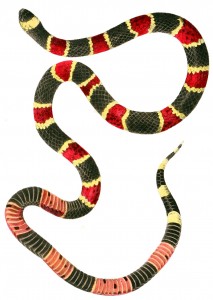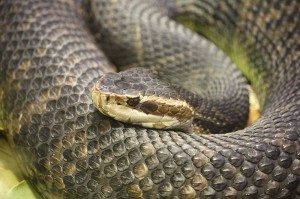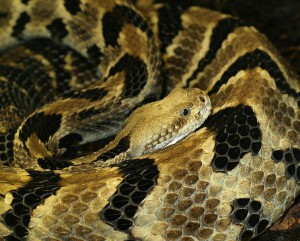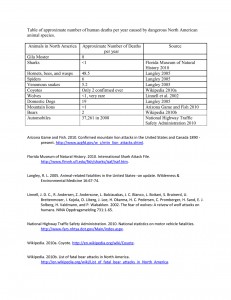This is the latest post in the Dangerous Animals series. Snakes cause some people to have a physical reaction of fear and revulsion, which is too bad as they are fascinating creatures. In many years as an educator about the natural world, I loved to use live snakes as examples. Many species can be safely handled and brought out with the public. They always create a stir among the viewers, some right up front with wide-eyed excitement, and others trying to appear casual while they move to the back of the crowd to let others get a good view.
I always respected the feelings of those folks who felt a bit uncomfortable, and ironically it was often the big, burly, macho males of the group for whatever reason. Numerous times in such situations I watched as the boy in class with great fear at first watched others touch the snake, with comments like “Oh, it is not slimy,” or “Wow, it feels cool,” and then slowly make his way to the front. It was always a great personal triumph when he screwed up his courage enough to tentatively reach out a finger to touch the snake and overcome some of his own demons.
As an aside, it also always upset me when I would see one spouse, usually the man, use one of the very realistic snake models we had to sneak up on his wife and scare her with it. That is not helping at all.
I think such fear is caused by a lack of understanding about these amazing creatures, and the knowledge that some of them are dangerous animals. That combination leads to lots of misinformation and confusion. The vast majority of snakes are harmless to humans, and all of them serve an important role in their ecosystems, being predators on small species helping to keep their numbers in check.
The venomous snakes of North America fall into two families: the vipers and the elapids. The vipers, more specifically pit vipers, include the copperhead (Agkistrodon contortrix), the cottonmouth (Agkistrodon piscivorus), and the rattlesnakes (about 30 species in the genera Crotalus and Sistrurus). The pit is a special heat-sensing organ located on either side of the head, between the eye and nostril, which allows the animal to track changes in temperature in its environment. This is most useful for tracking warm-blooded prey such as small rats at night, without needing light. In experiments, the snakes can be deprived of vision and a sense of small, and still stalk prey and strike with great accuracy.
The second group of venomous snakes belongs to the family Elapidae, the family that includes many deadly snakes such as cobras, sea snakes, and kraits. The coral snakes (Micrurus and Micruroides) are the New World representatives of this family. They live in three areas across the south. The eastern coral snakes lives in the Carolinas south to Florida. The Texas coral snake lives in Texas and Louisiana, and the Arizona coral snake lives in Arizona and extreme southern New Mexico. They are reclusive snakes, mostly living underground, are nonaggressive, and account for very few snakebites each year, which is a good thing because their venom is a very potent neurotoxin. Read more about venom here.
The copperhead is one of the most beautiful snakes in my opinion. They live in the eastern woodlands of North America, being found from Kansas and Oklahoma east through the southern and New England states.
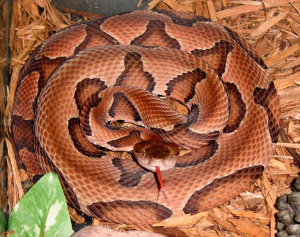
A copperhead snake, Agkistrodon contortrix, perhaps one of the most beautiful snakes in North America.
It can be found in northern Mexico in desert areas, but is closely associated with semipermanent water sources and riparian areas. It is a docile snake, and mostly relies on its coloration to keep it hidden. I have known hikers to step right over the snake without ever seeing it or having the snake react, which can also lead to bites when it gets stepped on directly. The venom of the copperhead is less toxic than the other pit vipers, and bites are generally less severe than from other venomous snakes.
There is a great deal of worry about the cottonmouth in the area that I grew up in, Ohio, which is ironic since they do not occur there. (I have observed this phenomenon over and over, with people being deathly afraid of species, having heard from so and so some horrific story about it, and just sure that they are of great concern when it does not even occur in the area. Humph.) They do occur across the southeast states, from extreme southern Virginia through Florida, and west to Oklahoma and central Texas.
The cottonmouth is closely related to the copperhead, but its temperament is not as docile. One of the reasons that this snake causes fear I think is because it can be hard to identify in the field if you are already predisposed to fear snakes. It is a heavy-bodied snake that is generally dark olive in color and resembles several species of harmless water snake. When threatened, the snake may open its mouth wide, flashing the white interior of its mouth as a warning, giving it the name cottonmouth. Its resemblance with several species of harmless snakes gives rise to far more “encounters” with cottonmouths being reported than actually occurs.
The rattlesnakes are a diverse group of snakes that only occur in the New World, and a species of rattlesnake occurs in every state in the contiguous United States expect for Maine. They do not live in Alaska or Hawaii. The largest native snake in North America is the eastern diamondback, which can reach over 7 feet long, although that is rare. (The indigo snake can be longer, but the eastern diamondback is heavier bodied.)
Their most obvious physical trait of rattlesnakes is the presence of the rattle, which is a modified string of scales on the end of the tail. The scales interlock in such a way as to allow the snake to shake its tail vigorously and cause the scales to rattle, giving notice to animals around it that it is there. As a warning system, it likely evolved so the snake could let large ungulates, that move in big herds, know that the snake was there specifically to avoid being stepped on. The snake most definitely would like to be left alone so it does NOT have to bite to defend itself. Listen to a rattlesnake here
Rattlesnakes would mostly like to avoid confrontations with humans too. When disturbed it will make its presence known and try to make a retreat. Some species are more likely than others to stand their ground and not flee. Bites most often occur when people fail to leave the snake alone, or surprise the snake unexpectedly, such as reaching under a log or into a rock crevice.
Venomous snakes do cause just over 5 deaths per year in North America (Langley 2005), and more bites that do not cause death, but injury and pain. (See this post for information about the number of bites each year). However, that number of fatalities and injuries caused by snakes pale in comparison with automobile deaths nationwide, with over 37,000 occurring in 2008. But automobiles are part of our everyday experience, which engenders a more blasé attitude generally than snake encounters.
Advice for outdoor adventures in areas where venomous snakes occur is pretty basic. Use common sense, be careful when around rocks and logs where you cannot see underneath, do not provoke any snakes encountered, and give the snake plenty of room to retreat. If a bite does occur, don’t panic and seek medical treatment right away. While a bite is a medical emergency, the modern antivenin available is very effective at mitigating snake venom
Langley, R. L. 2005. Animal-related fatalities in the United States–an update. Wilderness & Environmental Medicine 16:67-74.
